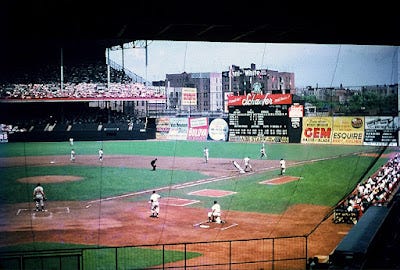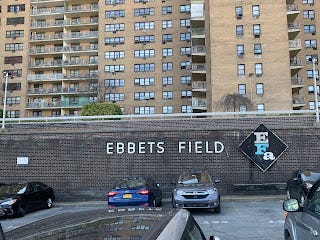Dodger Fandom Made Ebbets Field Special

The Dodgers welcomed their passionate fans into Ebbets Field as the fans welcomed “Dem Bums” into their homes and businesses.
by Rich Watson
Months ago, I outlined the Dodgers’ fandom when the team still lived in Brooklyn. To one not of that time, it’s hard to appreciate the tightness of the ties that bound that team to that place, and their point of convergence: Ebbets Field.
When I was younger, I dated a girl from Flatbush. She lived only minutes from the former site. At the time, neither of us knew much, if anything, about Dem Bums and what being part of that community meant.
Its like won’t be seen again.
Ebbets Field: the basic facts
Charles Ebbets owned the Dodgers in the early twentieth century. He commissioned construction of the ballpark in 1912, thinking it would be ready during the same year. It didn’t open until 1913. (One could say the mantra “Wait till next year” was part of Ebbets Field’s DNA.)
The Dodger franchise, born in 1884, probably went through more nicknames than any other MLB team, especially in the nineteenth century and the start of the twentieth:
Grays
Atlantics
Bridegrooms
Grooms
Superbas
Robins
“Dodgers” had spun off from “Trolley Dodgers,” back when Brooklyn had tons of trolleys.
The ballpark went through some expansions until by 1948, it became the Ebbets Field most familiar today. Its address was 55 Sullivan Place.
Ebbets was small compared to other ballparks: 399 feet to center field, with a 348-foot left field and a right field only 297 feet long.
It happened in Flatbush
The roots of the neighborhood we call Flatbush date back to the Dutch colonial days in the seventeenth century. In 1894, the city of Brooklyn incorporated it, and New York made all of Brooklyn a borough four years later.
The demographics shifted away from the Dutch towards more working-class Italians, Irish and Jews. Cars became more common.
Subways ran through Flatbush by this time: the BMT Brighton Line (the B and Q trains today) and the IRT Nostrand Avenue Line (the 2 and 5 trains). The Prospect Park station was where one would get off to visit Ebbets Field.
Who were the Dodger fans?
The website Flatbush History describes Dodger fans as a motley bunch who may have been divided in everyday life, but came together as one at Ebbets Field:
…After a day’s work, the people of Flatbush would go to the field—whether they were paying to go inside or just hanging around out back hoping to catch a homer—or put the game on the radio. Either way, they’d listen to the friendly voice of announcer Red Barber, who was known to say the bases were “FOB” (“full of Brooklyns”) when loaded. “If the words on the Statue of Liberty meant anything at all, they applied to Brooklyn in the old days,” Barber later said. “You had Blacks, Jews, Italians, Irish, Polish and others working hard to make a living, and they all cared passionately about their ball club.”
Pulitzer Prize-winning author Doris Kearns Goodwin wrote a memoir in 1997 about growing up a Dodger fan, Wait Till Next Year. Here she describes her first visit to Ebbets:
…The marble rotunda at the entrance to the shrine looked like a train station in a dream, with dozens of gilded ticket windows scattered around the floor. The floor tiles were embellished with baseball stitches, and in the center of the domed ceiling hung an elaborate chandelier composed of a dozen baseball bats. As we started through a tunneled ramp into the stadium, my father told me that I was about to see the most beautiful sight in the world. Just as he finished speaking, there it was: the reddish-brown diamond, the impossibly green grass, the stands so tightly packed with people that not a single empty seat could be seen.
There was Happy Felton, a TV show host who catered to junior Dodger fans. There was the amateur marching band known as the Dodger Sym-phony.
And there was Hilda Chester. A former softball player turned Ebbets Field concessionaire, one knew her by her voice. It was loud. It was constant. And it was directed at almost anyone at whom she had a mind to yell. Did I mention she also wielded a cowbell?
She embodied the Dodger fandom. The Dodgers themselves loved her as much as the other fans.
Dodgers living in Brooklyn
The Dodgers had accommodations in Brooklyn neighborhoods near Ebbets Field. It wasn’t unusual to see them and/or their wives on the streets.
Some players lived in Bay Ridge, such as Duke Snider. He lived on 178 Marine Avenue. This New York Times article written after Snider’s death in 2011 interviews neighbors acquainted with him when he lived there. Gil Hodges lived on 3472 Bedford Avenue. That section between Avenues L and N is only one of several places in Brooklyn named for him. This Brooklyn Eagle piece has beautiful photos of Pee Wee Reese’s old house.
Jackie Robinson lived in a Manhattan hotel room, then in an apartment in Bedford-Stuyvesant, before moving to a house at 5224 Tilden Avenue.
The book about Robinson’s rookie season, Opening Day by Jonathan Eig, describes the Covingtons, a black couple who befriended Robinson and his wife Rachel when they lived in Bed-Stuy:
…The Robinsons became regulars at the Sunday dinners. The Covingtons treated Jack warmly but casually, as if he were nothing special. Every so often, though, another dinner guest would react in amazement to Robinson’s presence at the table, gushing about how much the ballplayer meant to his race, how proud everyone was, how astonishing it was to see him there in the flesh.
Going to California with an aching in my heart
In 1955 the Dodgers won their one and only World Series in Brooklyn after twelve National League pennants. One can imagine the elation the borough felt after being bridesmaids for so many years.
That elation turned to despondency two years later when the team left for Los Angeles, at the same time their rivals, the Giants, moved to San Francisco.
The circumstances leading to their departure are well documented. In this WNYC interview, Michael Shapiro, author of The Last Good Season: Brooklyn, The Dodgers, and Their Final Pennant Race Together, not only exonerates owner Walter O’Malley of blame for the move, but suggests the reaction in Brooklyn wasn’t as melodramatic as one might think:
…by October of ‘57… this dance between L.A. and New York of are they staying or going, staying or going, to say nothing of whether the Giants are going to go to San Francisco, had gotten really, really tiring. And by the time they left there were a few sort of tepid rallies—keep the Dodgers in Brooklyn sort of thing—but by the time they left the reaction in the paper was I am sick of both of them, enough already. It had gone on for so long and it had been so drawn out that a) it didn’t come as a shock and b) was not attended by a week of mourning.
The Mets connection
Five years later, the Mets were born in Queens. From day one the new team worked at establishing ties to their forebears, in particular the Dodgers.
They wore blue and orange, the Dodgers’ and Giants’ colors. Former Dodgers and Giants played on those early Met teams. Hodges, a beloved ex-Dodger, managed the team to their first championship, in 1969. In 2001, the Mets established a minor league affiliate in Brooklyn. In 2009, the Mets moved to a ballpark designed as a tribute to Ebbets Field.
It has reached the point where comparisons between the Mets and their Brooklyn ancestors seem less far fetched, even after the birth of a new professional sports team based in Brooklyn.
But that’s how deep the Dodgers’ legacy runs in New York.
Over sixty years later…


Ebbets Field was demolished in 1960. A housing project stands in its place. The name “Ebbets Field” is now associated with a line of vintage sportswear.
Fewer people who remember the Dodgers’ time in Brooklyn remain. The memory of that team and that era remains strong. Some have eschewed nostalgic feelings and view them realistically.
Many, however, continue to cling to the idea of the Brooklyn Dodgers, a team of ne’er-do-wells and underdogs who beat the odds one glorious summer. Let the final word on the Dodgers and their fans come from another fan:
————————
Do you know someone who saw the Dodgers at Ebbets Field?

